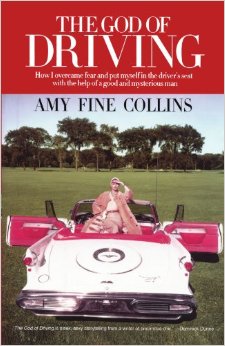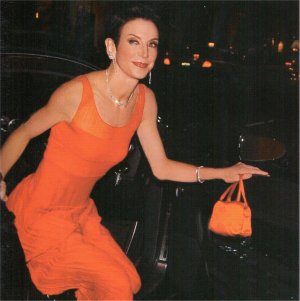Amy Fine Collins never thought learning to drive could be such racy stuff.

The God of Driving, by Amy Fine Collins
It is a modern cliché that glamorous people achieve their effect with ease, that really cool people never look as though they’ve made an effort, and so there is something refreshing about Amy Fine Collins, who has made an artform out of deliberateness. She speaks slowly and softly and every word seems to hang around in honour of the care with which it was chosen. She is a contributing editor at Vanity Fair and author of several books including a new memoir, The God of Driving: How I Overcame Fear and Put Myself in the Driver’s Seat (with the Help of a Good and Mysterious Man). Her writing is meticulous and well regulated, its insights concentrated, its wit sharp and purposeful, its technique evident. She is in the Best-Dressed Hall of Fame and is one of the most photographed women in New York. When you see her you always marvel at the intelligence that put together a particular hat, coat, pair of shoes, dress and handbag, because you can tell that every ramification of every item has been calculated.
She has short, dark hair, parted at the side, and rather severe features — large eyes always lined in heavy black kohl, an aquiline nose with a definite point, pronounced cheekbones, very red lips, a jutting chin and a long Marella Agnelli neck. She is tall has a completely vertical figure, muscular and taut, though she is well into her 40s. Like the Duchess of Windsor, she achieves with style what most women strive for with beauty. “I’m the antithesis of American standards of pulchritude: not blond, not busty and not symmetrical. So I work with what I have. I’m an art critic by training: I’m constantly criticising what things look like, and since the first thing I tend to see is myself in the mirror, that’s where I begin. I love the process of adornment.” She indulges in one of her prolonged pauses. “I am my own canvas.” Yet the overall effect of this control is not brittle and hard but sinuous, languid, warm. Despite being a glittering socialite, she is a kind and thoughtful friend, especially to people in their dark hours. “She’s one of the unique personalities of New York social life,” says novelist Dominick Dunne.
Her new book is a bestseller in the States, and Gwyneth Paltrow is looking at playing Amy in the movie. When Amy started driving lessons, she had to expose her much-protected inner self, and as her relationship with her enigmatic, darkly handsome Turkish instructor developed, she dared herself to examine profound feelings. It is an unconsummated romance that bridges class and context; it is the narrative of a patient discovering herself in the intense closeness of a quasi-psychoanalytic relationship, in which submitting to someone else’s gentle authority allows her the greatest independence she’s ever known.
It’s also a rollicking saga of wild overcompensation: by the end of the book, she’s on the racetrack at 180mph. “The high was less extreme this time — the kick of novelty was gone — but strangely enough, when the buzz subsided, it was replaced by serenity. What had happened was that the concentration on the daunting task of lapping was so intense, so absolute, so total, that all petty, annoying, worrying thoughts were blasted right out of my mind, vaporised into nothingness. It was 2am before I turned out my Venetian blown-glass bedroom light. All night long I dreamt I was doing laps, finding the apexes, using up as much of the track as possible.”
The God of Driving has opened new vistas for her. Automobile magazine raved and she has since become a popular speaker at car shows. She and her instructor have gone on the road together — literally and figuratively. She has slipped into honorary Hell’s Angel status dressed in leather astride a Ducati bike; she has become attached to publicists at luxury-car manufacturers, and she now swans around town in the world’s best automobiles, usually ones that haven’t yet been released to the public. “At first the idea of Amy Fine Collins behind the wheel of a car was a bit unnerving,” says Graydon Carter, editor of Vanity Fair. “But she approached her driving lessons as she approaches both her work and her life: with great wit and great intellect. Now she’s all over town, driving Bentleys and Maybachs.”

When she emerged from a posh vehicle at the opening of a recent fashion exhibition at the Metropolitan Museum, she was mobbed by paparazzi. A young journalist asked her whether there was any contradiction between her fashion career and her writing career, and she clarified: “I don’t have a fashion career — I have a fashion identity.” The journalist nodded, wrote it down, and said: “I guess I just wonder how you keep it all up. Don’t you need some time to unwind?” Amy smiled. “I plan on unwinding when I’m dead.”
She grew up the daughter of a Jewish psychiatrist in high-toned Bucks County in north-west Pennsylvania; went to Swarthmore College; did an MPhil in art history at Columbia, and was for a while Professor Fine to her students and to those who read her academic writing in cultural journals such as Art in America. She met her husband — a writer who applies psychoanalytic theory to Renaissance painting — when she was 23. She still joking refers to his well-heeled connections as his “class mates”, and claims she paints on varicose veins when she goes to the stuffy Colony Club, of which she is now a member; eyed at first with suspicion in the dowdy old-money world of Park Avenue, she is now seen as a rare bird, too exotic and brilliant to be dismissed. She doesn’t seek WASP status, which essentially bores her, but she plays the game with considerable grace.
In 1989, while writing for the hip, lefty Village Voice Style section, she reviewed an exhibition of Geoffrey Beene, America’s most sophisticated couturier, at the National Academy of Design. The day the piece ran, under the headline “The Wearable Lightness of Beene,” she received a huge arrangement of flowers and a note that said: “How can it be that you who have never met me understand me better than I understand myself?” Two weeks later, she and Mr. Beene (as he was known to everyone) had lunch and a brilliant partnership was born. She wore Beene, Beene, Beene until the day he died, aged 77, last September.
She was his exact type: tall, lean, dark, elegant, clever and unimpeachable, with an X-ray eye for detail. She said that he made her fantasies come to life; he said that she inspired his imagination, and often and publicly referred to her as “my muse”. When she was still figuring out her style, she told Beene, “I can look like anything as long as I don’t look like everyone else”, and she recounts being teased by her friends for being “always the shepherd and never the sheep”.
Early in their relationship he occasionally proposed designs that were “safe” for summers on exclusive Fishers Island, or for visiting her daughter’s school, and she said: “Safety at the expense of identity is not worth it to me.” Her friend Wendy Goodman, the interiors editor of New York magazine, says: “I sometimes run into her when I’m uptown, just on the street, and she wears the kind of clothes to go to the drycleaner that I send to the drycleaner.”
Beene introduced her to the magazine legend Grace Mirabella, who in turn brought her to Tina Brown’s Vanity Fair. She writes about the nexus of style and intelligence; her subjects range from Cézanne to Audrey Hepburn. “I still feel like I’m writing papers at school,” she says. “I still feel like I’m getting As to impress my parents. I was known as a smart kid and I still hold onto that; I have a big nerdy side, those anodyne mornings at the keyboard.”
In The God of Driving she makes no bones about her willed façade — you know what she wore to every damned lesson. It’s also a love story in which the narrator is arrestingly vulnerable. “‘When I was out of town,’ I said, ‘I missed you.’ I felt I owed him that, too. Caught off guard, he was unable for once to regulate his feelings. His face registered first surprise, then delight. It lingered briefly at embarrassment, moved on to tenderness, and finally calcified into impassivity, its habitual expression. And when he collected himself, he said, ‘New York is an empty place without you.'” Having spent a lifetime creating a perfect shell, she chose to emerge from it in her memoir, and because she made that process visible, the book feels brave. If her persona has been the consequence of effort, this stepping out of the persona has required 10 times as much effort, and that is why her tale is so moving and so pleasurable.
Amy Fine Collins recently declined an invitation to curate a retrospective exhibition of lingerie designs by Victoria’s Secret. “I’m really interested in outer garments, the ones you see,” she said when she recounted the decision. She cocked her head slightly to one side, a pair of Forties Cartier eardrops catching the light, her smile wry. “Outer garments and inner thoughts,” she explained.











